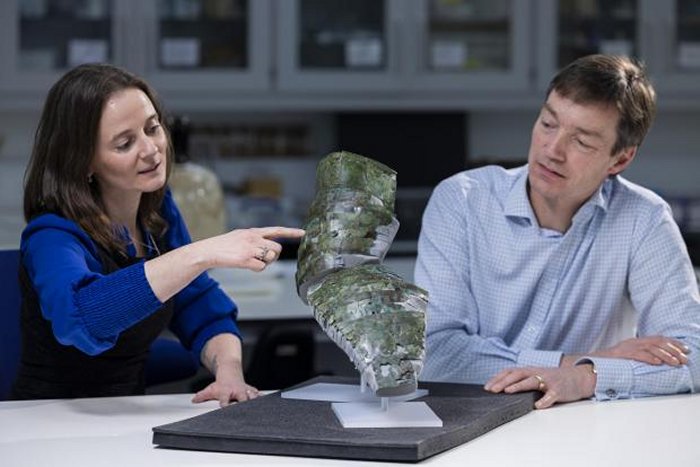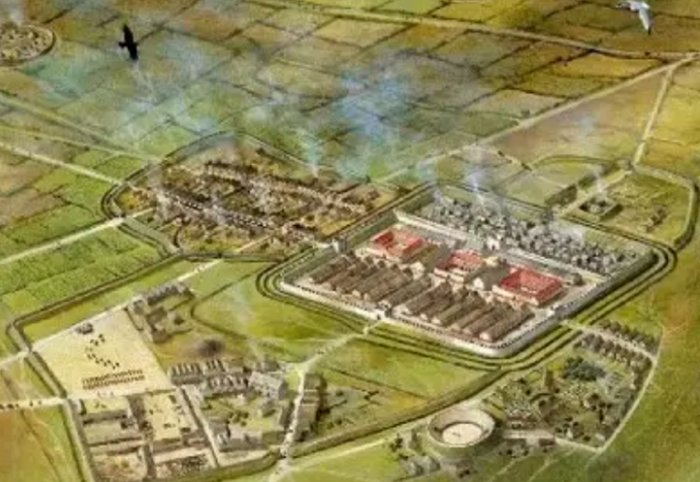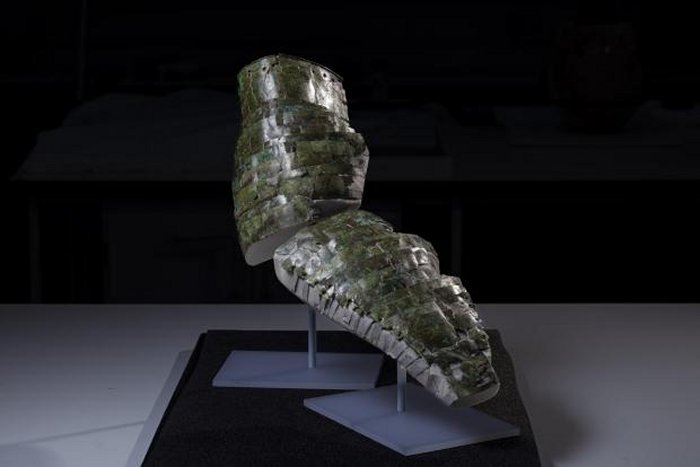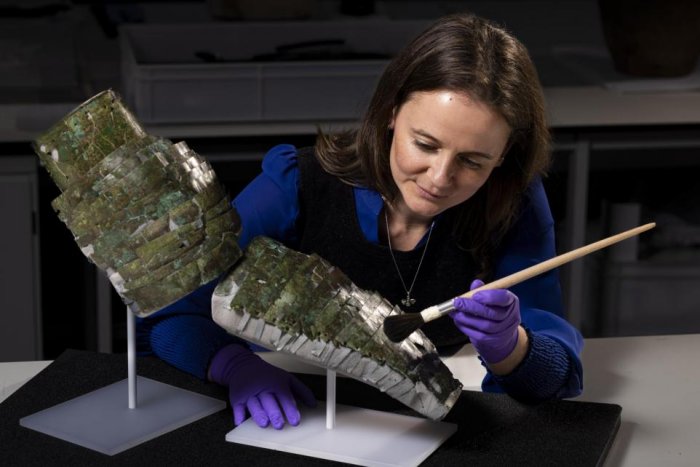Jan Bartek – AncientPages.com – For the first time in almost 2,000 years, the public will have an opportunity to see an incredible Roman arm guard.
This ancient arm guard is truly unique because it is one of only three known from the whole Roman Empire.
Found in 1906 at the Trimontium fort site near Melrose, Scottish Borders, the brᴀss guard owned by National Museums Scotland has been reconstructed from more than 100 fragments!

Bethan Bryan and curator Fraser Hunter with the extremely rare piece of Roman armor. Credit: Duncan McGlynn/National Museums Scotland
It took conservators several weeks to reᴀssemble the magnificent object that protected the sword arm of a high-ranking Roman soldier some 1,800 years ago.
The Trimontium Roman Fort holds a special place in the history of Iron Age Scotland. Being occupied intermittently from about 79 to 184 A.D., the Trimontium Roman Fort was rediscovered in 1846 during construction works of a Victorian railway cutting east of Newstead village. At the height of its glory, the Roman fort accommodated between 2,000–5,000 people.

A reconstruction of the Trimontium Roamn Fort. Credit: Trimontium Museum
“Trimontium was more than just a fort. Defended annexes protected a civilian community which had travelled with the troops. The families lived here along with traders and craftworkers, for this was also an industrial complex. Furnaces and kilns smoked as iron was smithed, pots were fired and glᴀss jewellery was made.” 1
It was the second largest Roman fort after the construction of Hadrian’s Wall in the 120s A.D.
One of these intriguing ancient objects is the arm guard belonged to one of the thousands of Roman soldiers stationed at the Trimontium Fort.
While most arm guards were made of iron, which was more functional, brᴀss would have looked golden on the wearer’s arm, marking out a soldier’s rank on the battlefield.

The brᴀss arm guard is owned by National Museums Scotland. Credit: Duncan McGlynn/National Museums Scotland
“This is an incredibly rare object, and it’s great that this exhibition gave us the opportunity to rebuild it.
The transformation is striking. Now that it’s been reconstructed, you can picture the legionary who once wore it. It was both protection and status symbol – brᴀss was expensive and would have gleamed like gold on his sword arm.
It offers a vivid connection to this important period when Scotland sat on the Roman Empire’s northern frontier,” said Dr. Fraser Hunter, the NMS’s principal curator of prehistory and Roman archaeology.
Putting together the 100 pieces has been a challenge.
“Approaching this ancient jigsaw puzzle required careful consideration and it was important to make sure we could display the piece in a manner as near as possible to how it would have looked 2,000 years ago.
“I’m thrilled that it can now be seen by audiences in a new light and has been preserved for generations to enjoy,” Bethan Bryan, ᴀssistant artifact conservator at National Museums Scotland, said.
Richard Abdy, the curator of Roman and Iron Age coins at the British Museum, said hosting the exhibition is a “splendid privilege.”
“The flexible arm guard is an iconic piece of equipment for Roman gladiators, so it is unusual to see it as a sword arm protection for Roman soldiers too.

The piece of Roman armor from the second century was reconstructed from dozens of fragments. Credit: Duncan McGlynn/National Museums Scotland
Its display, posed with classic legionary segmental body armour, is stunning. The latter is also possibly derived from gladiator kit and we even think that the training regime for the amphitheatre originally inspired combat training of the professionalising Roman army.
The image of Roman soldiers and gladiators appropriately unite in one artefact – two characteristic strands of the dark side of Roman civilisation that have long fascinated public imagination,” Abdy said.
The Roman arm guard will go on permanent display in the National Museum of Scotland in Edinburgh after the British Museum exhibition ends.
The British Museum’s Exhibition – Legion life in the Roman army lasts from 1 Feb 2024 to 23 Jun 2024.
Written by Jan Bartek – AncientPages.com Staff Writer
Expand for references
- National Museums Of Scotland – Romans in Scotland: major archaeological sites





